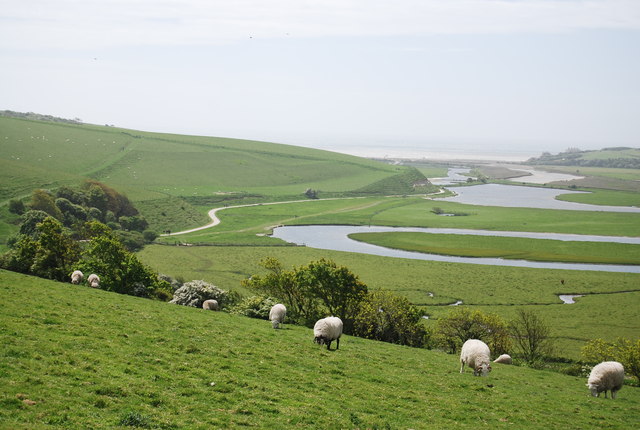 |
| Picture 1: The meandering River Cuckmere in the South Downs, East Sussex, UK |
About water where I live
Living in a part of the world that has abundant water, and at
the same time reading about drought-stricken parts of the world, I am compelled
to take a closer look at this magical resource, water, especially freshwater,
that we humans and many others in the web of life depend upon. I’m very fortunate to live in
southeast England, in an area called the South Downs (Pic. 1) which receives on an
average, 950 mm of rainfall per year (Pic. 2; Met Office 2015). The local geology of the area further helps
in containing the rainwater, as the bedrock is Chalk (Pic. 3), a type of powdery
textured Limestone, which serves as an excellent aquifer for storing as well as
filtering water to keep it pure and clear.
The island of United Kingdom receives most of its rainfall from
moisture-laden winds blowing over the Gulf Stream, the warm surface current in
the Atlantic Ocean (UK Environmental Change Network 2015).
 | |||||
| Picture 3. Chalk cliffs in the South Downs. |
 |
| Picture 2. Average annual rainfall in the UK |
The future scenario
What I’ve described above is wonderful in that those of us living here should have no concern for freshwater availability. However, we are faced with a warming climate and consequently the possibility of changing patterns of atmospheric and oceanic circulations. In the future, the Gulf Stream may change its course and the UK may not benefit from its warm waters for its moderate climate and abundant rainfall. Another cause for concern in the near future regarding the availability of freshwater in the southeast is from the activity of hydraulic fracturing (fracking) of shale rock for obtaining methane gas. The South Downs area has been identified as a shale rock hydrocarbon resource (British Geological Survey 2015a). If fracking is done, large quantities of fresh water will be required, and there is the added concern of contamination of underground water aquifers as well as surface water bodies with the chemical fluids used for fracking, although the British Geological Survey argues otherwise (British Geological Survey 2015b).A preemptive strategy for living with water rather than living for water
Bearing the future scenario in mind which may alter the current situation of
plentiful water in southeast England, here is a strategy for
sustainable living to help cope with future water shortage as well as its conservation. If every home has a water-meter installed it will give users a clear idea of how much water they use, and how they could reduce
their consumption, if possible. Home
backyards or gardens could have a vegetable patch where vegetables and fruits that
are endemic (local) to the area can be grown.
This will help reduce the water footprint of the household, if an effort
is made to eat vegetables that grown naturally in an area. This is already done to some extent in the UK where people rent a patch of land called an allotment, from the local city council, for growing fruits, flowers, and vegetables. Foraging courses could be offered by
city councils to educate people on edible plants that grow naturally (or invasively) in an
area. In a region of abundant rainfall,
houses could easily reduce their water bill and help conserve water by installing a rainwater harvesting system (Pic. 4; Innovating Water Solutions 2015; Mother Earth News 2015) that
collects rainwater, which could be used for watering the garden and for various other uses where tap-water is not exclusively required. Eco-friendly household appliances could be used which
consume less water and electricity. As an example, for small and less soiled laundry loads, a mechanical washing machine could be used (Pic. 5, Goods Home Design 2015).
 |
| Picture 4. A rain barrel for harvesting rainwater. |
 |
| Picture 5: Pedal-powered washing machine. |
To reduce the water
footprint as a result of energy usage, government incentives could be given to
households to use energy sources that consume less water such as photovoltaic
cells and wind-powered electricity. Industrial and government buildings should
implement this scheme wherever possible. Community colleges, universities and other
institutions that disseminate information and education should play an active
role in raising public awareness on water-related issues and the mitigation of
the same. Super-markets and local
grocery stores should have 'water-footprint' leaflets of common food products made available to shoppers, which may make people more aware of their
own water footprint while shopping for groceries.
I live very close to my work place, so I walk to work every
day, which makes my commuting water footprint nil. I am also a vegetarian, and although my food
water-footprint is lower than regular meat-eaters, I do realise that by
consuming wheat, rice, oils, fruits, and vegetables, I have a significantly
large indirect consumption of water, which I
am now looking to reduce. I am also looking into ways by which I can
reduce my annual usage of refrigerator and electricity appliances.
Bibliography
British Geological Survey. 2015a. “Jurassic shale of the
Weald Basin: resource estimation report.” Accessed 02 May. http://www.bgs.ac.uk/research/energy/shaleGas/wealdShaleOil.html
British Geological Survey. 2015b. “BGS maps help understand
relationship between groundwater and fracking.”
Accessed 02 May. http://www.bgs.ac.uk/news/docs/aquifersAndShales_FINAL.pdf
Goods Home Design. 2015. “Pedal-Powered Washer Needs No Electricity and Costs Only $40.” Accessed May 02. http://www.goodshomedesign.com/pedal-powered-washer-needs-no-electricity-and-costs-only-40/.
Innovative Water Designs. 2015. "Rainwater Harvesting Methods." Accessed May 04.
Met Office. 2015. “How much does it rain in the UK?” Accessed May 02. http://www.metoffice.gov.uk/learning/rain/how-much-does-it-rain-in-the-uk.
Met Office. 2015. “How much does it rain in the UK?” Accessed May 02. http://www.metoffice.gov.uk/learning/rain/how-much-does-it-rain-in-the-uk.
Mother Earth News. 2015.
“Build a Rainwater Harvesting System.” Accessed May 02. http://www.motherearthnews.com/homesteading-and-livestock/rainwater-harvesting-system-zmaz03aszgoe.aspx.
UK Environmental Change Network. 2015. "3.1 Factors affecting climate-ocean currents." Accessed 04 May. http://www.ecn.ac.uk/what-we-do/education/tutorials-weather-climate/climate/factors-affecting-climate
Picture sources:
Picture 1: http://www.geograph.org.uk/photo/4272716
Picture 2: http://www.metoffice.gov.uk/learning/rain/how-much-does-it-rain-in-the-uk
Picture 3: http://en.wikipedia.org/wiki/South_Downs
Picture 4: http://www.watercache.com/images/education/rain-barrel.jpg
Picture 5: http://www.goodshomedesign.com/pedal-powered-washer-needs-no-electricity-and-costs-only-40/






